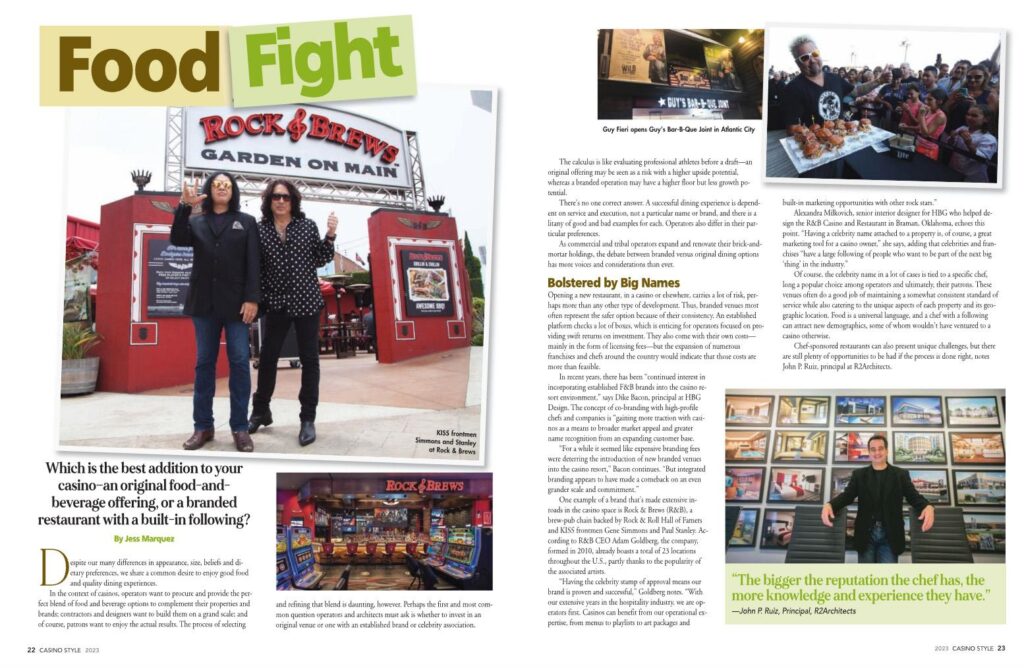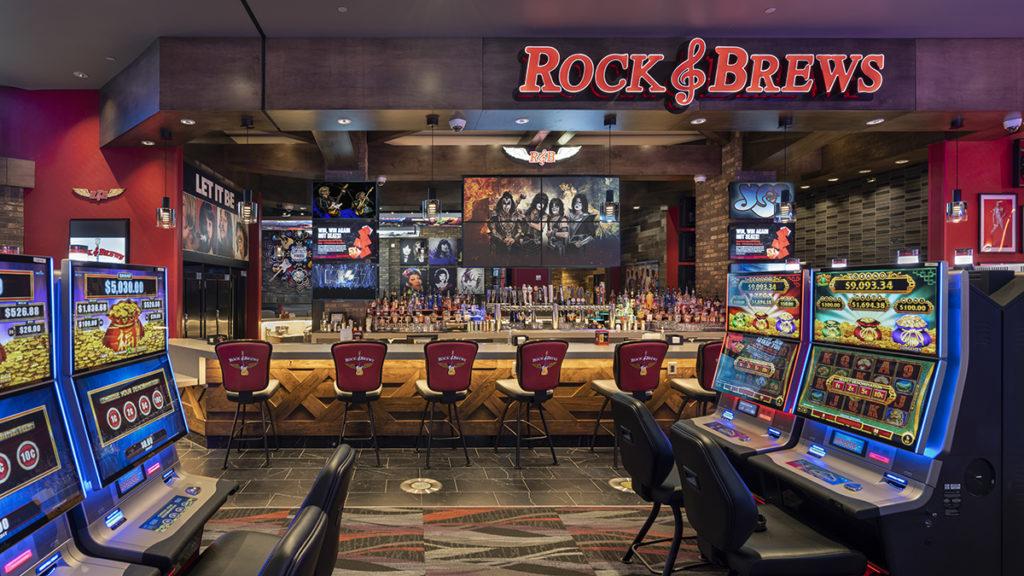Food Fight
Which is the best addition to your casino—an original food-and-beverage offering, or a branded restaurant with a built-in following?
 Despite our many differences in appearance, size, beliefs and dietary preferences, we share a common desire to enjoy good food and quality dining experiences.
Despite our many differences in appearance, size, beliefs and dietary preferences, we share a common desire to enjoy good food and quality dining experiences.
In the context of casinos, operators want to procure and provide the perfect blend of food and beverage options to complement their properties and brands; contractors and designers want to build them on a grand scale; and of course, patrons want to enjoy the actual results. The process of selecting and refining that blend is daunting, however. Perhaps the first and most common question operators and architects must ask is whether to invest in an original venue or one with an established brand or celebrity association.
The calculus is like evaluating professional athletes before a draft—an original offering may be seen as a risk with a higher upside potential, whereas a branded operation may have a higher floor but less growth potential.
There’s no one correct answer. A successful dining experience is dependent on service and execution, not a particular name or brand, and there is a litany of good and bad examples for each. Operators also differ in their particular preferences.
As commercial and tribal operators expand and renovate their brick-and-mortar holdings, the debate between branded versus original dining options has more voices and considerations than ever.
Bolstered by Big Names
Opening a new restaurant, in a casino or elsewhere, carries a lot of risk, perhaps more than any other type of development. Thus, branded venues most often represent the safer option because of their consistency. An established platform checks a lot of boxes, which is enticing for operators focused on providing swift returns on investment. They also come with their own costs—mainly in the form of licensing fees—but the expansion of numerous franchises and chefs around the country would indicate that those costs are more than feasible.
“In recent years, there has been continued interest in incorporating established F&B brands into the casino resort environment,” says Dike Bacon, principal at HBG Design. The concept of co-branding with high-profile chefs and companies is “gaining more traction with casinos as a means to broader market appeal and greater name recognition from an expanding customer base.
“For a while it seemed like expensive branding fees were deterring the introduction of new branded venues into the casino resort,” Bacon continues. “But integrated branding appears to have made a comeback on an even grander scale and commitment.”
One example of a brand that’s made extensive inroads in the casino space is Rock & Brews (R&B), a brew-pub chain backed by Rock & Roll Hall of Famers and KISS frontmen Gene Simmons and Paul Stanley. According to R&B CEO Adam Goldberg, the company, formed in 2010, already boasts a total of 23 locations throughout the U.S., partly thanks to the popularity of the associated artists.
“Having the celebrity stamp of approval means our brand is proven and successful,” Goldberg notes. “With our extensive years in the hospitality industry, we are operators first. Casinos can benefit from our operational expertise, from menus to playlists to art packages and built-in marketing opportunities with other rock stars.”
Alexandra Milkovich, senior interior designer for HBG who helped design the R&B Casino and Restaurant in Braman, Oklahoma, echoes this point. “Having a celebrity name attached to a property is, of course, a great marketing tool for a casino owner,” she says, adding that celebrities and franchises “have a large following of people who want to be part of the next big ‘thing’ in the industry.”
Location, Location
Of all the factors that influence the F&B decision-making process, two are perhaps most important: the location of the venue within the casino and the size of the casino itself. Often, these details will help the process shake out—or, as R2A’s Ruiz puts it, “you can start to peel the layers off the onion.”
“It really varies,” he says. “And what I mean by that is the size of the property—does it have three to five outlets, or does the property have 15 to 20 or 25 or more food-and-beverage outlets? How large is the property? That’s where these things start.”
Renovations and expansions of existing spaces are more common than brand-new builds, which means that casinos often have a predetermined space in which to fit a venue, and there are do’s and don’ts that correspond to that scenario.
As Cuningham’s Houck says, “One of the bigger questions is, what do you want to fill if it’s a large casino? It’s kind of like 101—you don’t put a Mexican place next to another Mexican place. So there is a sense of looking at what’s needed.”
Additionally, changes in patron preferences can make certain concepts outdated, and renovating can allow operators to “remain responsive to changing market conditions and new branding opportunities and to refresh a property’s offerings,” says HBG’s Milkovich.
Casinos big and small are like mini-ecosystems, constantly trying to find the best flow, the best integration of amenities and gaming. As such, companies will vary in their brands and tastes (no pun intended), and architects and designers will work to keep pace with those changes.
“Different clients and different properties have different techniques or theories behind it,” SOSH’s Sochocky explains. “Some clients we work with actually like their top restaurant all the way at the back of a casino, so they can draw people through the casino floor to get to it. Some of our clients like it at the front door… Their gaming floor also has a lot to do with it. It does become a little bit of a game of real estate.”
Regardless of the type of venue, it’s clear that the true beneficiaries are the patrons, the ones who get to fully enjoy the experiences that operators, designers and architects work so hard to create. A truly successful venue is one that can satisfy its target audience, again and again and again.

 “In recent years, there has been continued interest in incorporating established F&B brands into the casino resort environment,” says Dike Bacon, principal at HBG Design. The concept of co-branding with high-profile chefs and companies is “gaining more traction with casinos as a means to broader market appeal and greater name recognition from an expanding customer base.
“In recent years, there has been continued interest in incorporating established F&B brands into the casino resort environment,” says Dike Bacon, principal at HBG Design. The concept of co-branding with high-profile chefs and companies is “gaining more traction with casinos as a means to broader market appeal and greater name recognition from an expanding customer base.